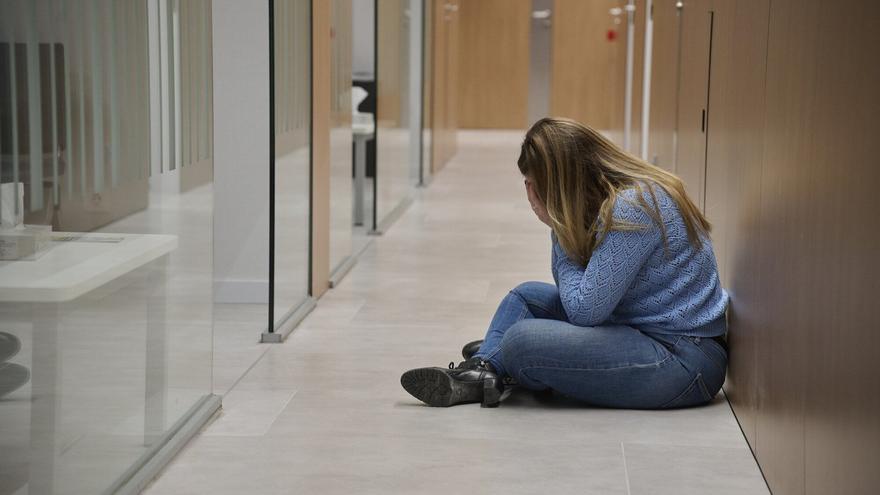The Navarrese minors who resort to Mental Health Network have increased 21.4% in the last five years. Specifically, last year the Child and Youth Mental Health centers in Navarra served to a total of 5,161 minors under 17 years of age, almost 1,000 more than those received before the pandemic (4,248 in 2018)which for many children and adolescents – and for the population in general – had a very negative impact on their emotional well-being.
These are data extracted from Osasunbidea activity reportswhich also show a 12% increase in this time in adults served by the Mental Health Network, with a total of 28,628 people in 2023.
The question of mental health –whose World Day is celebrated this coming Thursday– has been gaining weight in the public sphere due to the increase in demand, especially after the pandemic, which, according to the Mental Health manager of Osasunbidea, Sara Chivite– had “an impact on the health and emotional well-being of the population”, due to social isolation, loss of role, uncertainty and fear.
An example of this, explains Chivite, were suicides, which, while they did not increase during the first year of the pandemic, “In 2021 there was an increase in the suicide rate of 32%”. “We cannot establish direct causality but the negative consequences at a health, economic and social level could have influenced this aspect,” he points out.
Likewise, the number of people diagnosed with a mental disorder has not stopped growing in the last decade in Navarra, reaching 6,702 people in 2023, according to data from the Social Reality Observatory, although Chivite clarifies that “serious disorders remain stable ”. “The increase in mental health problems is more related to social determinants, gender, personal, family, social or economic experiences, as well as poverty. and stress factors such as immigration. These are some of the factors that affect people’s mental health,” he says.
It is true that, according to the experts, part of this increase could be explained by the progressive increase in the population in Navarra and for the normalization that is gradually being given to mental healthan issue that has always been surrounded by a strong taboo, and which causes greater and greater use of services.
The peak in young people in 2021
The negative impact of the coronavirus has been felt especially among children and adolescents, with an increase in the number of patients undergoing surgery. The increase in care that had been recorded before the pandemic reached its peak in 2021, with 5,237 minors treated.
Last year, fThere were 5,161, of which 59% were boys. According to the data managed by those responsible for the Pamplona Child and Adolescent Mental Health center, the most common diagnosis was a behavioral disorder (oppositional defiant disorder, conduct disorder, depression, etc.), but It is striking that 20.7% of these children and adolescents were not diagnosed with any mental disorder.but rather they came to the consultation due to emotional discomfort (stress, low self-esteem, etc.)
Regarding activity, the number of consultations in children and youth centers rose to 27,822 in 2023, 5.2% more than the previous year and 31.8% more than in 2018, with first consultations experiencing a greater increase than revisions.
Anxiety and depression, main disorders
In the case of adults, it is observed that there was an increase in first consultations – patients seen for the first time – in the two years after the start of the pandemic. However, the total number of queries has been increasing (15.83% since 2018) progressively until 174,322 in 2023which indicates “a greater frequency of consultations and an increase in the number of patients being treated,” explains Chivite.
In total, last year the ten Mental Health centers in Navarra treated 28,628 patients, a figure slightly below the 30,038 in 2022. but 12% higher than the 25,552 patients in 2018. Unlike in minors, More women (54%) than men (46%) attended.a difference that is explained because the two most common pathologies – anxiety and depression – are more common in women than in men.
According to the Mental Health manager, anxiety appears in 88.4% of women and depression in 58.5%while in men these percentages remain at 45.2% and 23.3%, respectively, with schizophrenia or substance use disorders being more frequent in them.
Almost 1,000 patients are on the waiting list
Last August it closed with almost 1,000 patients waiting for a first consultation with Mental Health. This is a high figure that, however, has been reduced considerably in the last two years, going from the 1,294 people who were waiting at the end of 2022, to the 992 who did so last August, 23% less.
However, waiting times have not changed that much in this time: While in December 2022 the average delay was 36 days, currently it is only two days less (34). Furthermore, so far this year the situation has worsened – as in the rest of the specialties, which set a record in August with more than 70,000 people waiting for a first consultation– since in January there were 58 fewer people on the Mental Health waiting list (934) and the average waiting time was 30 days.
Waiting lists and delays in receiving treatment are one of the priorities for the Health Department and one of the issues that most concern patients.as stated in the 2023 Osasunbidea Report. This document reflects the claims filed by users and, in the case of Mental Health, Of the 280 complaints collected throughout last year, 118 (42%) were due to waiting lists.
